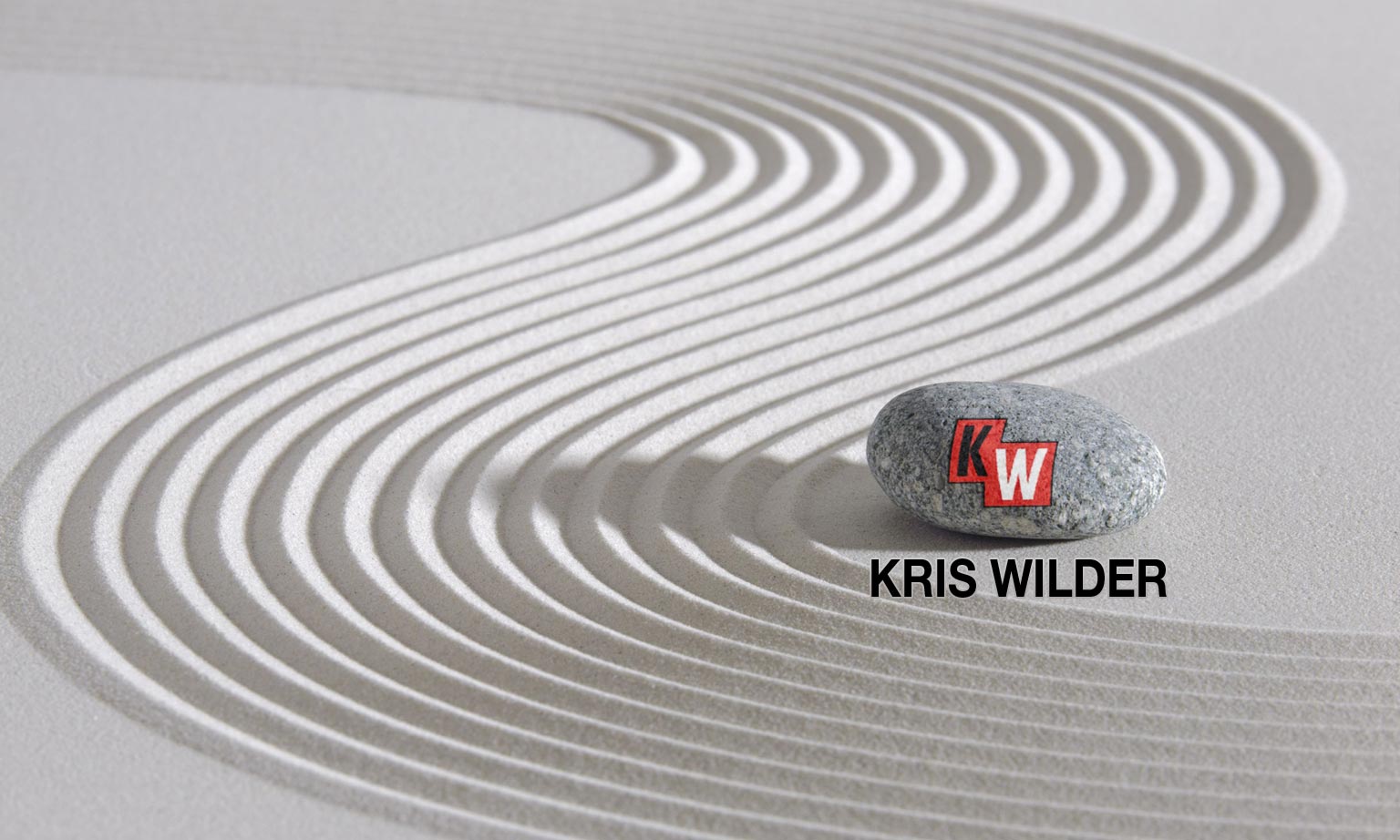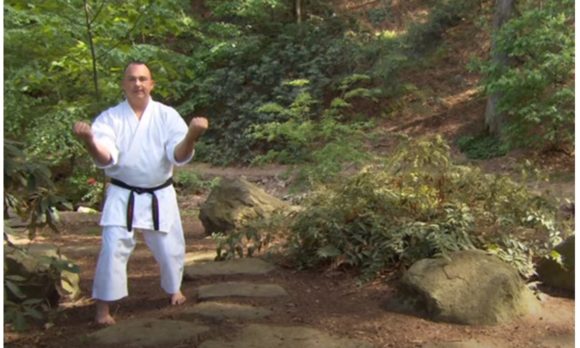
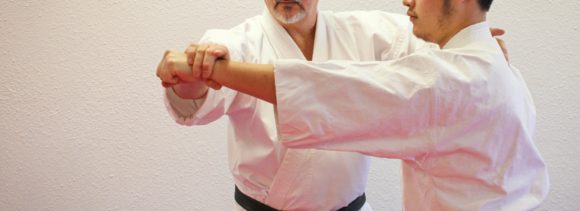
The Sanchin kata testing was dynamic. After the examination, we gathered around the new Godan. The finger imprints from the teachers slapping the new Godan shoulders resonated red. The fingerprints appeared buried deep in his sweat-covered skin.
Being freshly minted black belts, we worked our way around his torso, calling out, “Look at this one!” We discovered with reverence more marks left on his body from the test. Later I would come to learn, I had bought into the falsehood that these marks indicated good, strong karate.
Sanchin Testing
Shime testing is a two-person drill. Shime testing serves as a way of seeing a practitioner’s ability to apply the strategies and tactics of Sanchin kata.
The idea behind the testing is to have the practitioner placed under a load, to see their structure. To do this we use shime testing. The testee will be performing the kata. Then there will be a second person who is testing their body.
The testing involves putting pressure on the testee’s body. Further, the intent is to find the weak spots in the structure. The goal being discovery, so the practitioner can correct a weakness.
What is seen as classical testing, striking the testee with impetus, is a modern affection. As a result this form of testing is incorrect in its application and also its goal.
To gather some perspective around the idea of shime, take a look at the word. Shime translates to mean: to lock, tighten, or shut.
Shime is used to judge the practitioner’s ability to lock the body down. This locking down or tightening shuts off the areas of vulnerability. Further the locking down also provides a strong platform from which to strike. The fact is shime is all about the performer of the kata and conversely little to do with the tester.
Sanchin Striking Force
Percussive striking forces the body and mind into a form of triage. Triage is a medical term. Triage is a means of analysis that determines the priority of treatment. The analysis is ordered by the severity and survivability of the injury.
The body will instinctively use triage to address the force of the strike and not analyze the test. In fact the body wants to figure out what threat gets addressing first? The body takes that threat and using triage puts a threat to number one about importance. Structure, education, exploration, information, go to the bottom of the order.
The goal in Sanchin testing is the betterment of the student and not a display. When betterment is the goal then the method of percussive striking is not helpful. It is difficult to analyze and understand the feedback of a quick strike in a meaningful fashion.
More on this with an example you can apply, but before that here are a couple of quotes to underscore the point:
“Slow is smooth, smooth is fast.”
“To build may have to be the slow and laborious task of years. To destroy can be the thoughtless act of a single day.” – Winston Churchill
“Wisely, and slow. They stumble that run fast.” – William Shakespeare “Somebody asked me – you know, how come it took you so long to win a national championship? And I said, ‘I’m a slow learner; but you notice when I learn something, I have it down pretty good.” – John Wooden
The Slow Pace of Sanchin Kata
The percussive method of testing a person’s Sanchin Kata is of little value. It’s as they used to say. “All show and no go,” or “All hat and no cattle.” Excessive slapping, kicking, punching may only constitute 1% of good testing of Sanchin. It looks great – too childish eyes.
Sanchin kata is performed at a slow pace allowing for an audit of movement. In turn, the tester should honor this pace. The slow pace allows the testee the building of an overarching and unified structure.

Example of Sanchin Kata Testing
During the performance of the Sanchin kata, the tester will often station themselves behind the testee. From this rear position, the tester will place both hands on the Trapezius muscle.
The Trapezius muscles run from the base of the skull to the lower thoracic vertebra on both sides of the body. For our purposes, the Trapezius muscles serve as a shelf to place the tester’s palms.
Testing involves placing the tester’s palms on the testee’s shoulders (Trapezius muscles). Once the hands are in position the tester slaps down hard several times.

Experience and education are poor in this example. The actions are percussive force, and not load. A load is a weight or source of pressure by a person on the testee.
The second, and preferred method, is to place the hands on the shoulders. Then pushing downward trying to drive the person into the ground. One element being tested is the flexibility of the spine.
The spine should have no flexibility. The bones should be stacked allowing for the transfer of energy. The is transfer should go into the ground in this example of testing.
This method of adding load to the practitioner allows them to audit their stance. During this testing, a weakness, for example in the lower spine, can be fixed with realigning the vertebrae.
By striking quickly and hard on the practitioner the experience is less favorable. In response to a strike, the testee will compresses and springs back into place using triage. This method allows no time for subtlety, study, or remediation.
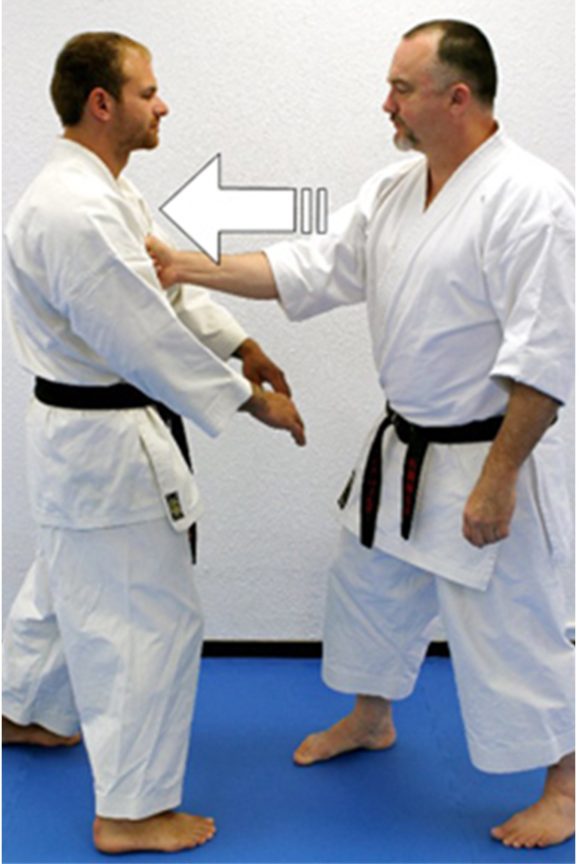
Steady pressure
Similar methodologies are used by IKEA, the home furnishing company. IKEA will test a chair with a machine that slowly and repeatedly sits down on the chair until the chair fails.

These two examples of product testing countermand the popular Sanchin testing method. The explosive and percussive methods of testing Sanchin, are not used by Underwriters Unlimited (UL) or IKEA. UL and IKEA both seek information and not a broken object. Sanchin testing should carry the same reasons and methodologies.
Learn Slow to Learn Sanchin Kata Faster
The percussive striking of modern-day Sanchin testing is an affectation. Dynamic striking of the testee is not a pathway for success. Using percussive striking as a primary means of testing lacks understanding of the goal of shime testing.
Another way to put it is, you want to use the time on the floor well, and get as much information as you can to the student. It’s a form of honoring the moment and all involved.
The old method of testing Sanchin kata is that of a building load and not percussion. The testing is about allowing the student to study their body and the teacher aiding the student.
An example of this is in my book, The Way of Sanchin Kata; The Application of Power and the follow-up DVD, Sanchin Kata; Traditional Training for Karate Power.
When you are assisting a student. During the auditing of the testee you will address the cardinal points of the compass. (North, South, East, West) The other four intermediate directions are also used. These points are also known in their classic Japanese terms; Happo Kuzushi. These are the traditional eight directions of imbalance.
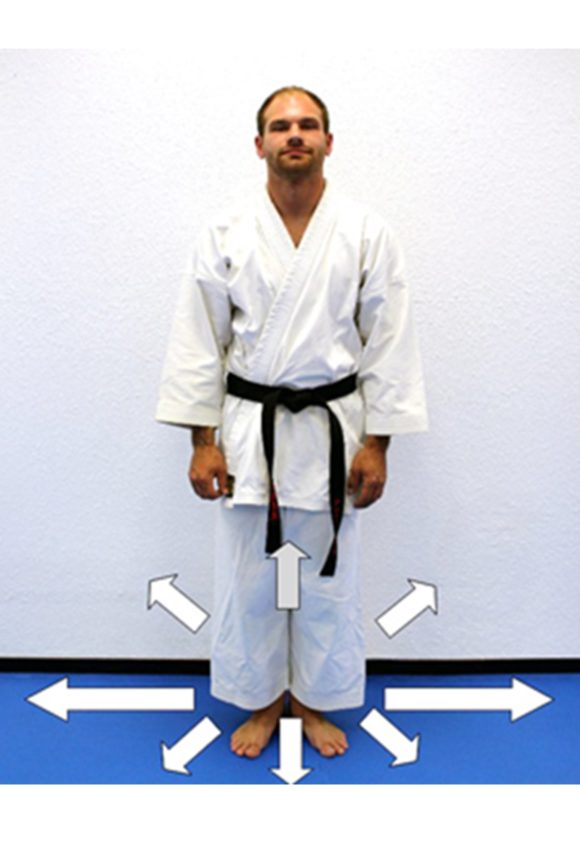
Sanchin Training Tips
As the practitioner performs Sanchin kata, use your fist to give pressure in a direction. For example, from front to back, (North to South) on the practitioner’s chest. Increase the pressure until you feel the practitioner losing their structure. Then hold that position allowing them to adjust their body to meet the load you are placing on them. Above all this is subtle and cooperative.
This is where wisdom and instruction come in. It is the tester’s responsibility to aid the testee. By adding corrections, and pointing to discoveries the testee is gaining better performance.
As you can see, the entire process of shime for Sanchin kata is about cooperation and study, and not brute force.
Sanchin is practiced in a dojo, “The hall of the way.” The testing should be seen as co-education, not a competition. Study and learn. Adopt methods, sometimes old methods, study, learn, and improve.
Sanchin Kata Links
Here is a promotional video, It is the introduction pulled from the Sanchin DVD I did for YMAA Publications. Sanchin Kata; Traditional Training for Karate Power.
The video is long at 7:35 minutes.
Stay with it until you get what you want, and then exit. I trust it is to your liking.
Here is a little extra.
A brief selection from The Back Channel Podcast, the topic Consistency. Consistency is an element of good karate practice and is a corner stone to Sanchin kata practice. Sometimes we all need a boost and here it is.
Twitter I Facebook I Instagram I YouTube I West Seattle Karate Academy I Martial Arts & Life Podcast I The Back Channel Podcast I Courses
Do you want more? Here are some courses both free and upper-level courses
The Brutally Simple / Simply Brutal courses + more at Kris Wilder Courses
More than just information, wisdom. https://kriswildercourses.teachable.com/
